
An octopus is a soft-bodied, eight-limbed mollusc of the order Octopoda. The order consists of some 300 species and is grouped within the class Cephalopoda with squids, cuttlefish, and nautiloids. Like other cephalopods, an octopus is bilaterally symmetric with two eyes and a beaked mouth at the centre point of the eight limbs. The soft body can radically alter its shape, enabling octopuses to squeeze through small gaps. They trail their eight appendages behind them as they swim. The siphon is used both for respiration and for locomotion, by expelling a jet of water. Octopuses have a complex nervous system and excellent sight, and are among the most intelligent and behaviourally diverse of all invertebrates.

A cephalopod is any member of the molluscan class Cephalopoda such as a squid, octopus, cuttlefish, or nautilus. These exclusively marine animals are characterized by bilateral body symmetry, a prominent head, and a set of arms or tentacles modified from the primitive molluscan foot. Fishers sometimes call cephalopods "inkfish", referring to their common ability to squirt ink. The study of cephalopods is a branch of malacology known as teuthology.

Teuthology is the study of cephalopods. Cephalopods are members of the class Cephalopoda in the Phylum Mollusca. Some common examples of cephalopods are octopus, squid, and cuttlefish. Teuthology is a large area of study that covers cephalopod life cycles, reproduction, evolution, anatomy and taxonomy.

Opisthoteuthis californiana, also known as the flapjack octopus, or flapjack devilfish is a species of umbrella octopus.

The giant Pacific octopus, also known as the North Pacific giant octopus, is a large marine cephalopod belonging to the genus Enteroctopus and Enteroctopodidae family. Its spatial distribution encompasses much of the coastal North Pacific, from the Mexican state of Baja California, north along the United States' West Coast, and British Columbia, Canada; across the northern Pacific to the Russian Far East, south to the East China Sea, the Yellow Sea, the Sea of Japan, Japan's Pacific east coast, and around the Korean Peninsula. It can be found from the intertidal zone down to 2,000 m (6,600 ft), and is best-adapted to colder, oxygen- and nutrient-rich waters. It is the largest octopus species on earth and can often be found in aquariums and research facilities in addition to the ocean. E. dofleini play an important role in maintaining the health and biodiversity of deep sea ecosystems, cognitive research, and the fishing industry.

The Pacific ocean perch, also known as the Pacific rockfish, rose fish, red bream or red perch, is a fish whose range spans across the North Pacific : from southern California around the Pacific rim to northern Honshū, Japan, including the Bering Sea. The species appears to be most abundant in northern British Columbia, the Gulf of Alaska, and the Aleutian Islands.
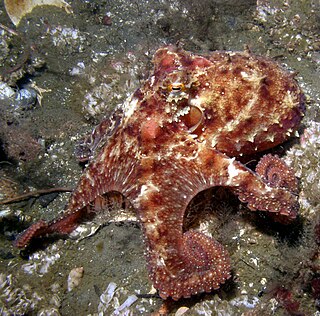
Octopus rubescens is the most commonly occurring shallow-water octopus on much of the North American West Coast and a ubiquitous benthic predator in these habitats. Its range extends from the southern Gulf of California to at least the Gulf of Alaska, but may also occur in the western Pacific Ocean. O. rubescens occurs intertidally to a depth of 300 m (980 ft).
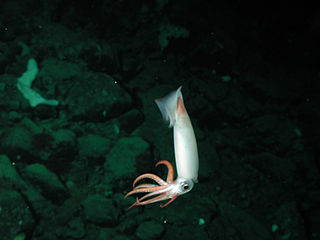
Gonatus onyx is in the class Cephalopoda and in the phylum Mollusca. It is also known as the clawed arm hook squid or the black-eyed squid. It got these names from the characteristic black eye and from its two arms with clawed hooks on the end that extend a bit further than the other arms. It is a squid in the family Gonatidae, found most commonly in the northern Pacific Ocean from Japan to California. They are one of the most abundant cephalopods off the coast of California, mostly found at deeper depths, rising during the day most likely to feed.

Enteroctopus megalocyathus, also known as Patagonian red octopus (EN), Pulpo del sur (Chile) and Pulpo colorado (Argentina); is a medium-sized octopus, and the type species for the genus Enteroctopus.

Cephalopod ink is a dark-coloured or luminous ink released into water by most species of cephalopod, usually as an escape mechanism. All cephalopods, with the exception of the Nautilidae and the Cirrina, are able to release ink to confuse predators.
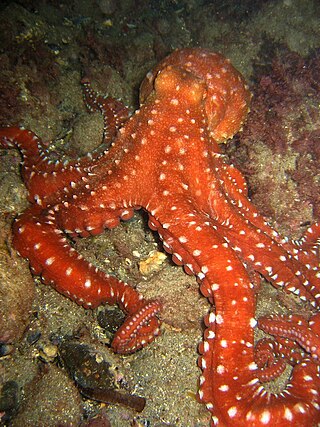
Callistoctopus macropus, also known as the Atlantic white-spotted octopus, white-spotted octopus, grass octopus or grass scuttle, is a species of octopus found in shallow areas of the Mediterranean Sea, the warmer parts of the eastern and western Atlantic Ocean, the Caribbean Sea, and the Indo-Pacific region. This octopus feeds on small organisms which lurk among the branches of corals.

Sepioteuthis lessoniana, commonly known as the bigfin reef squid, tiger squid, glitter squid, oval squid, or northern calamari, is a species of loliginid squid. It is one of the three currently recognized species belonging to the genus Sepioteuthis. Studies in 1993, however, have indicated that bigfin reef squids may comprise a cryptic species complex. The species is likely to include several very similar and closely related species.
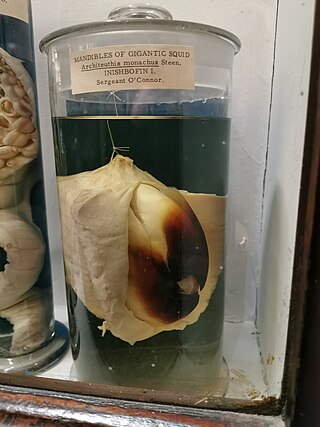
All extant cephalopods have a two-part beak, or rostrum, situated in the buccal mass and surrounded by the muscular head appendages. The dorsal (upper) mandible fits into the ventral (lower) mandible and together they function in a scissor-like fashion. The beak may also be referred to as the mandibles or jaws. These beaks are different from bird beaks because they crush bone while most bird beaks do not.

Octopus salutii or the spider octopus is a species of cephalopods in the family Octopodidae. It ranges from 4.0 to 13.0 cm ML in males and 3.5 to 16.5 cm ML in females. Octopus salutii are found at depths ranging from 100 to 700m however, they are most abundant at depths of 250 to 500m.
Octopus oliveri, is a species of octopus found in the western Pacific Ocean off the coast of Japan, Hawaii, and Kermadec Island, in reefs and boulder coasts.

Bathypolypus sponsalis, commonly called the globose octopus, is a deep sea cephalopod that can be found in both the eastern Atlantic Ocean and the Mediterranean Sea. It possesses many morphological traits adapted to a deep sea environment, including large eggs, reduced gills, no ink sac, and subgelatinous tissues. A distinguishing factor are the relatively large reproductive organs. Their diet consists of predominantly crustaceans and molluscs, but they sometimes consume fish as well. Bathypolypus sponsalis usually dies quickly after reproduction and only spawns once in their lifetime. Sexually mature females have a mantle length of at least 34 mm and sexually mature males have a mantle length of about 24 mm. Juveniles are white and transition to dark brown then to dark purple once maturity is reached.
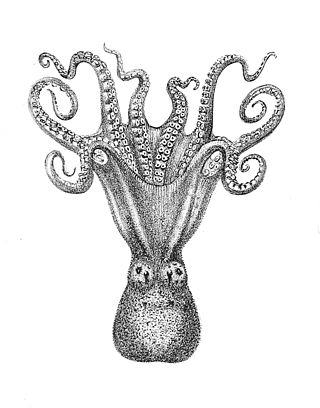
Octopus australis is a species of octopus. It gets the common name hammer octopus from a modified arm possessed by males and used in reproduction. It was first described by William Evans Hoyle in 1885, based on a specimen found in Port Jackson in New South Wales.

Octopus conispadiceus is a species of long-ligula octopus, provisionally placed in the genus Octopus. It was first described by Madoka Sasaki in 1917 based on specimens bought at a fish market in Sapporo, Japan.
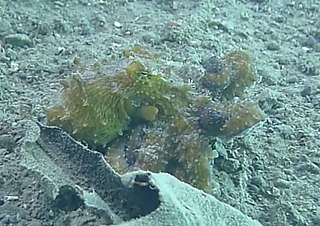
Abdopus abaculus, or the mosaic octopus, is a species of pygmy octopus. It was first described as Octopus abaculus by M. D. Norman and M. J. Sweeney in 1997 based on specimens caught in Zamboanga del Norte, Philippines.
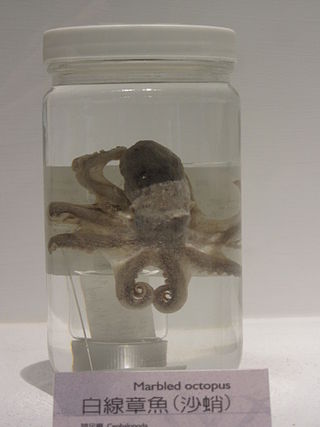
Amphioctopus aegina, commonly referred to as the marbled octopus or the sandbird octopus, is a bottom dwelling species residing in the coastal zone of the Indo-West Pacific. Planktonic hatchlings and eggs are laid by females predominantly during the months of January and October, however they have been known to reproduce year-round.


















